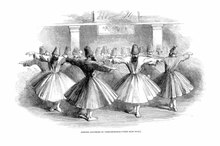Chinese Arm Swing Exercise
If you take a class in tai chi you'll also learn about qi gong, as it is usually practiced within a tai chi class. The term "qi gong" refers to energy or the source of life, and the practice involves controlled breathing and movement. The arm swing exercise is an example of one movement you might perform as a warm-up when going through a tai chi routine.
Performing the Arm Swing
To do the arm swing exercise you'll start by standing on a level and firm surface with your feet shoulder-width apart. Starting at your hips, rotate your torso to the left. Your arms should be hanging loosely at your sides and will move only because your body is moving and not because you consciously make an effort to move them. This causes the swinging action that the name of the exercise describes. When you've turned as far left as you comfortably can, reverse direction, turning to the right and allowing your arms to swing limply as they follow your body. As you continue turning from side to side your arms will begin to lightly slap at your body. Rather than performing repetitions of the arm swing exercise, the movement is usually timed. In the book "Consumer Health: Spectrom of Choices," the recommendation is to do arm swings for 10 to 15 minutes.
Variation
Dance Exercise for Seniors
Learn More
Arm swings are an effective warm-up exercise to get your blood flowing, but you can add an element of challenge and enhance the workout with a little modification. In his book on self-healing, Maoshing Ni tells readers that they can increase the workout two or three minutes into an arm swing exercise by lifting the heels and bending at the knees as the arms swing back and forth. After a few minutes more you can make the exercise even more challenging by jumping up as your arms swing, imagining that the momentum of your arms is drawing your body up. Ni advises jumping progressively higher for five minutes then gradually slowing down to a stop.
Benefits
According to the book "Principles and Practice of Stress Management," not a lot of studies focus on the mental benefits of qi gong, although practitioners of the tradition claim that qi gong energy exercises like the arm swing work together to alleviate anxiety and depression and improve mental health overall. Harvard Health reports that tai chi, the practice within which qi gong is performed, is helpful for a number of physical maladies including arthritis, heart disease, Parkinson's disease and stroke. Specifically, the arm swing exercise does stimulate increased blood flow through the movement as well as the slapping action of your hands as your arms swing, indicating that it is beneficial to your cardiovascular system and demonstrating how it can be helpful when it comes to medical matters of the heart.
Starting a Qi Gong Program
10 Daily Habits to Increase Your Productivity
Learn More
In "Dragonfly Qigong," Michael Steward writes that the best way to learn about the benefits of qi gong is to try it yourself. You will learn principles of qi gong by attending a tai chi class, but if you want to concentrate exclusively on qi gong outside of another practice, you can find a qi gong instructor, a private teacher who can direct you as you learn about and work with energy. It's possible to get qi gong instruction from a book or a DVD, but Steward points out that there is a lot to be learned from personal interaction with an instructor that can't be communicated through an impersonal method like reading or watching a video.
Related Articles
References
- Consumer Health: Spectrom of Choices; Larson
- Harvard Health: The Benefits of Tai Chi
- Secrets of Self-Healing; Maoshing Ni
- Qigong Exercise for Daily Health and Wellness; Noel Castro
- The Complete Idiot's Guide to T'ai Chi & QiGong Illustrated, Fourth Edition; Angela Wong Douglas and Bill Douglas
- Principles and Practice of Stress Management; Paul M. Lehrer, et al.
- Dragonfly Qigong; Michael Steward
Writer Bio
Elle Di Jensen has been a writer and editor since 1990. She began working in the fitness industry in 1987, and her experience includes editing and publishing a workout manual. She has an extended family of pets, including special needs animals. Jensen attended Idaho and Boise State Universities. Her work has appeared in various print and online publications.









